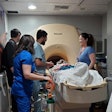
The need to improve performance in healthcare has never been greater: Customers expect more, good employees are hard to find, staff is having to do more with less, and competition is intensifying, according to an August 1 presentation at the 2021 AHRA meeting in Nashville, TN.
 Michael Janis of St. Anthony's Memorial Hospital.
Michael Janis of St. Anthony's Memorial Hospital.Presenter Michael Janis, executive director of outpatient and ancillary services at St. Anthony's Memorial Hospital in Effingham, Illinois, said that when preparing to launch continuous improvement performance initiatives, many find themselves asking, "Where do I start?"
His answer: Go for the gold.
A group called the Illinois Manufacturing Excellence Center (IMEC) provides hospitals in Illinois with bronze, silver, and gold awards based on headway they make in continuous performance improvement. St. Anthony's started by achieving a bronze award for commitment to excellence, which it received in 2018, and then last year, the hospital received a silver award for progress toward excellence.
Setting a goal of achieving a recognition award is a simple way to kick-start a strategy.
"There's nothing better than learning from the process," Janis said.
Founded in 1875 by two Franciscan sisters, St. Anthony's is a 133-bed licensed acute care facility that provides inpatient, ambulatory, home health, and hospice care, with more than 700 "colleagues" (employees/caregivers) and 70 physicians on staff. Janis and colleagues began their continuous performance improvement journey five years ago.
One of the most important decisions was to involve lay people and members of the public in the process. Healthcare professionals tend toward tunnel vision and can miss the big picture, Janis said.
In one case, a clinic renovation, the team brought in stakeholders from the public to assess the project. The group laid a Styrofoam model of the plan on a table and invited comments on sticky notes. Some suggestions were as simple as whether there should be a TV in the corner or whether the bathroom could be closer -- "ideas we wouldn't normally have looked at," Janis said.
A second pivotal piece of their strategy was the development of a booklet called "I Promise (To Make a Difference)," which encourages colleagues in the hospital to embody the following four core elements of the organization's mission in their interactions with patients and with each other:
- Respect: Building relationships by listening to your concerns and taking appropriate action
- Care: Connecting compassionately by understanding and focusing on your needs and making them my priority
- Competence: Being reliable by sharing my talents, compassion and bringing comfort to all
- Joy: Showing recognition by honoring your individuality and serving you in the manner of St. Francis
Janis and colleagues expanded on the "I Promise" concept by creating what they called the "I Promise Room," a dedicated space in the hospital where representatives from every department have the opportunity to gather in "safety huddles" to discuss any pressing needs or concerns. These sessions are ongoing and held four times a day.
The fact that this part was in place when the COVID-19 pandemic developed was crucial to the way the hospital responded to the crisis, Janis said. Colleagues at St. Anthony's are confident moving forward that the hospital has a structure in place to handle unexpected events.
"We're primed for whatever comes next," Janis said.
The specific way colleagues at the hospital communicate with each other in those safety huddles and elsewhere has had a huge impact on their efforts. They use a tool known as Situation, Background, Assessment, Recommendation (SBAR), which was designed to improve cascading communication.
SBAR in fact was first developed by the U.S. Navy specifically to ensure clear communications on nuclear submarines. It wasn't long before it was adopted in healthcare in the early 2000s, and it is now widely used.
SBAR sets expectations and frames a conversation in four parts:
- S = Situation: a concise statement of the problem
- B = Background: pertinent and brief information related to the situation
- A = Assessment: analysis and considerations of options -- what you found/think
- R = Recommendation (action requested/recommended) -- what you want
The communications tool can be applied in most situations because it standardizes the communication process. It also develops teamwork and fosters a culture of patient safety.
"Improving communication leads to less frustration and safer outcomes," Janis said.
Tying the "I Promise" and SBAR tools together at St. Anthony's is a continuous improvement method called Plan-Do-Check-Act (PDCA). PDCA "cycles" are iterative and can be applied at any organization level. They are designed for testing possible solutions, assessing results, and then implementing the ones proven to work.
An important factor not on paper but important to the process is that most administrators at St. Anthony's have experience working on the front lines in healthcare, Janis said. This helps them embody the I Promise core values, he said.
So, is gold next? Ultimately, once St. Anthony's achieves that state-level recognition, Janis and colleagues plan to measure up to performance excellence criteria under the National Institute of Standards and Technology's Baldrige program.
"The journey is continual, and we continue to learn as we go," he concluded.




















